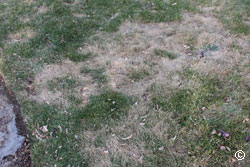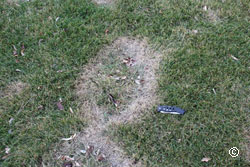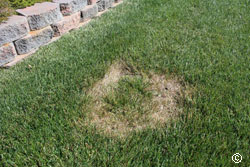
The symptoms of necrotic Ring spot (NRS), which include the formation of ‘frogeye’ patches of live grass in the center of an outer circle, will appear in the summer in Kentucky bluegrass lawns. While the grass roots become infected by this root-rot fungus in the late spring, the frogeye symptoms appear later in the year as temperatures rise in the summer. This is a disease of Kentucky bluegrass, while tall fescue and perennial ryegrass are not affected. Contrary to what is often written about this disease, there are no reliably resistant bluegrass varieties.

The fungus that causes NRS is a root-rotting fungus, so it is more common on lawns that are kept very moist during the spring and early summer. Heavy fertilization with quickly available (water-soluble) nitrogen in the spring will also increase the potential for this disease. Compacted soils and heavy thatch accumulation, which discourage healthy root formation and growth, can also stimulate NRS. Management practices to prevent or reduce the severity of NRS include: keeping soil on the drier side in the spring and early summer by closely monitoring irrigation frequency and amount, reducing or eliminating early spring applications of fertilizer containing high percentages of quickly available nitrogen, and spring and/or fall core cultivation (aeration) to decrease soil compaction and reduce thatch accumulation. Mowing grass at a height of 2.5 to 3 inches will increase root health and assist in recovery of turf afflicted by this disease. While affected areas will often heal during the fall, winter, and early spring, the disease will often reappear in lawns where management practices that stimulate the disease are not altered. Afflicted lawns can be overseeded with perennial ryegrass to hide damaged areas, since this grass species is not affected by the NRS fungus.
Those uninformed about this disease will sometimes recommend that soil in affected lawns be removed – often to depths of 6-12 inches – and replaced with new “topsoil” prior to sodding or seeding a new lawn. This is an expensive, misguided, and INEFFECTIVE approach to the management of this disease. Further, there is no way to sterilize or otherwise rid soil of the organism that causes NRS. Finally, contrary to popular belief, the fungus is NOT moved from one lawn to another on mowing or aeration equipment.
 Fungicide applications may help with recovery of infected turf, but only if accompanied by changes in cultural programs as discussed above. Fungicides will not be effective if watering and fertilization practices are not modified to improve turf health. Not all fungicides are effective against this disease; those available to the public in garden centers and nurseries are largely ineffective against NRS and should not be applied with the hope of controlling the problem. Licensed lawn care applicators have access to more effective fungicide products – but they are only effective when applied at the correct time of the year. Applications should be made in spring when soil temperatures reach 65 degrees F. (mid-May) at a soil depth of 2 inches. A second application should be made 28 days later – with a third application recommended 28 days following the second. See CSU Extension Fact Sheet 2.900, Necrotic Ring Spot in Turf grass, for further information.
Fungicide applications may help with recovery of infected turf, but only if accompanied by changes in cultural programs as discussed above. Fungicides will not be effective if watering and fertilization practices are not modified to improve turf health. Not all fungicides are effective against this disease; those available to the public in garden centers and nurseries are largely ineffective against NRS and should not be applied with the hope of controlling the problem. Licensed lawn care applicators have access to more effective fungicide products – but they are only effective when applied at the correct time of the year. Applications should be made in spring when soil temperatures reach 65 degrees F. (mid-May) at a soil depth of 2 inches. A second application should be made 28 days later – with a third application recommended 28 days following the second. See CSU Extension Fact Sheet 2.900, Necrotic Ring Spot in Turf grass, for further information.



